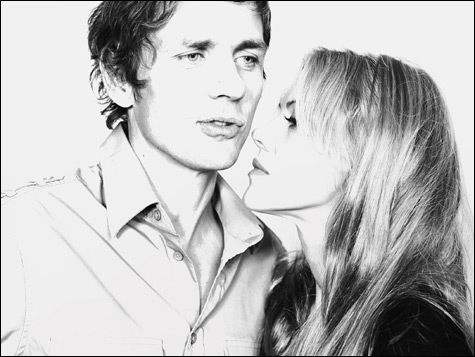
SIMPLE PLEASURES "Warhol wanted people to work hard, sure," says Dean Wareham, "but just as often, he wanted to do what was easiest." |
Dean Wareham and Britta Phillips, who come to the ICA this Saturday, have been playing a lot of museums lately, and that's been nice for them. "For one thing, they have nice toilets," Wareham says over the phone with an audible grin.Coming from a veteran performer with prolific past lives in benchmark bands like Galaxie 500 and Luna who's played pretty much any lousy, defunct rock club you can remember, Wareham's delight in sparkling facilities is easy to take at face value. But if the latest Dean & Britta project — 13 Most Beautiful . . . Songs for Andy Warhol's Screen Tests (Plexifilm) — is true to the artist it honors, innocence is only the surface of subterfuge.
"We weren't about to say no," says Wareham of the commission they received from Pittsburgh's Andy Warhol Museum to score a selection of the Screen Tests. "But when you hear 'Andy Warhol,' you think 'high art,' and I slowly started to realize how scary a project this could be."
Of course, Warhol is the one who turned high art on its head to begin with; his soup cans and Liz Taylors deflated the puffy existential tensions of the Abstract Expressionists, upturned traditional notions of beauty, and opened the halls of official art culture to the gaudy, fabulous masses. Wareham was happy to find that Warhol's idiosyncrasies sometimes came as comforts: "He wanted people to work hard, sure, but just as often, he wanted to do what was easiest. One day, he'd just say, 'Oh, I like boring things.' "
Boring, too, is in the eye of the beholder, and if the passage of time and the swelling of irony have led Warhol's raising of the mundane to the sublime right back to the mundane, the Screen Tests provide a fresh look at the dark human beauty that hides beneath his often pithy surfaces.
Filmed (or occasionally delegated out) by Warhol between 1964 and 1966, the 500-plus screen tests were shot both as practical measurements of the "star quality" of various visitors to his Factory space and as documents of an era of artistic explosion in NYC: poets from Ashbery to Ginsberg; musicians from Nico to Donovan; and, of course, Factory regulars like Edie Sedgwick, Billy Name, Paul America, and Ingrid Superstar — a good handful of whom made the cut onto Dean & Britta's set list. Subjects were asked to sit still and not blink for three minutes. Wareham and Phillips discovered that these minor restrictions could trigger brilliant transgressions.
"They're like a psychological test," says Wareham. "People sit down with the intention of projecting a certain image, but at some point, they break — and a second self begins to emerge."
These fissures in composure fascinated the two, but it made selection a bitch. Do you want Baby Jane Holzer brushing her teeth or chewing gum? Is the slipping of the camera in Richard Rheem's test a flaw or an opportunity? Are tears better when they're incidental (as were Ann Buchanan's after three minutes of staring) or accidental (as were Ingrid Superstar's — who, "with a half-minute to go, looks like she's about to die"). Is Dennis Hopper's troubled Method acting authentic? Or is Freddy Herko's troubled authenticity acting? (Likely not for the latter case, who danced out of a fourth-floor window on Cornelia Street a month after sitting for his test.)
If nothing else, the Screen Tests are a window into a lost avant-garde — one in which Dean & Britta's music fits oddly well. Although the Tests were filmed at 24 fps, they are played back (on disc and in the couple's multimedia performances) at 16 fps; this gives them a nostalgic, ghostly feel (here and there especially appropriate, since five of the 13 chosen subjects are now dead), and it boils down Warhol's "15 minutes of fame" to something more like four.
The pace and length are well suited to Dean & Britta's efficient (yet sufficiently meandering) brand of dreamy pop. Rather than impart a strong sense of milieu to the accompanying songs (as Wareham might have done in composing for more narrative films, like Noah Baumbach's The Squid and the Whale), the two strove to capture the particular mood of each test. "You know when you've got it wrong," says Wareham. The resulting music glows with a timeless quality that complements the everlasting youth and oddball beauty of Warhol's silent subjects — even as we know that none of it can last except as a series of images across a strip of film. It's sad and happy, grim, and beautiful — everything at once, as Warhol liked it.
"Maybe it's just romantic and stupid," Wareham concludes, "but some of them just feel heroic."
DEAN & BRITTA PERFORMING 13 MOST BEAUTIFUL . . . | ICA, 100 Northern Ave, Boston | March 21 at 7 + 9:30 pm | $25 | 617.876.4275 or www.worldmusic.org